Thomas W. Schaller captures the intersection of the natural and the manmade
By Bonnie Gangelhoff
This story was featured in the August 2012 issue of Southwest Art magazine. Order the Southwest Art magazine August 2012 print edition here, or purchase the Southwest Art magazine August 2012 digital download here. Or simply click here to subscribe to Southwest Art magazine and never miss a story!
New York. London. Rome. Tokyo. Thomas W. Schaller has captured many of the world’s great cities in watercolor. His alluring depictions of towering skyscrapers and iconic bridges can cause viewers to wax nostalgic for places seen or inspire wanderlust for those not yet visited. “While I love to paint cityscapes and buildings, I have found that it is the dialogue between, and the collision of, the natural and manmade worlds that makes the most compelling subject matter for me,” Schaller says. “The fascinating ways in which buildings interact with the sky and the landscapes where they are placed form countless surprising and beautiful compositions of positive and negative shapes—rich darks and sparkling lights.”
Schaller has long been considered one of the foremost commercial architectural artists in the world, receiving numerous awards for his renderings. He has worked with top architects in the country, including Michael Graves, Tod Williams, and Billie Tsien. In 1991 Schaller received a major award from the American Institute of Architects for his best-selling book Architecture in Watercolor, published by Van Nostrand-Reinhold.
But in 2005 he made the life-changing decision to devote his talents to a full-time career in fine art, and today he regularly receives recognition for his expressive, atmospheric urbanscapes. Last year Schaller was featured in Southwest Art’s “Artistic Excellence” competition, one of a select group of 21 artists culled from more than 2,000 entries. This month his work is also presented in Splash 13, Alternative Approaches: The Best of Watercolor published by North Light Books. The book features works by leading watercolorists and explores their various imaginative routes to creating great paintings.
While Schaller has lived and painted in cities around the world, today he makes his home in Venice, CA, a Southern California beach town on the west side of Los Angeles. Inspiration for his current works springs from bike rides along the coast or forays into downtown L.A., where he sketches its textured streets and historic buildings. He paints daily on location or in the studio behind his home, and he travels regularly across the country and abroad to give watercolor workshops.
When asked about his favorite subject matter to paint in the world’s great cities, Schaller has a ready answer: bridges. The watercolorist explains that he has always been drawn to stories about changes and transitions. “The idea and purpose of a bridge is transition—to cross over time and space as we travel from one spot to another,” he says.
Schaller also enjoys the challenge of representing a multidimensional bridge on a two-dimensional sheet of paper. “A bridge must imply not only the usual three dimensions of height, width, and depth but something of the fourth dimension of time as well,” he says.
Perhaps no painting of Schaller’s more succinctly conveys his mission of depicting distance and time than PONTE FABRICIUS, ROME. The piece portrays the landmark bridge on an autumn day in 2009. An admitted architectural-history geek, the artist says he had visited Rome before but had never seen the ancient structure and felt compelled to see it. The painting he created afterward depicts figures walking across the bridge over the Tiber River to Tiber Island. “The goal is to draw the viewers in and put them in the scene so they can imagine they are there,” Schaller says, and they can imagine the distance and the time the journey takes. “I want viewers to follow the path of the bridge through the painting. If I am successful, viewers will feel pulled along emotionally and recall something like it in their memories.”
Ponte Fabricius was built in 62 B.C. and is considered the oldest bridge still existing in its original state in the entire world. In creating the piece, Schaller says he tried to convey a monumental span of time in addition to conveying the time it takes to cross the bridge. “Because Ponte Fabricius is so old, I wanted a veil of trees in the foreground to feel like a curtain almost pulled back so you can look through the ages to the present and to the very distant past,” he says. “I wanted the background to be hazy and less distinct because it’s farther away. The buildings are almost dreamlike, emerging in the midst and implying the passage of time.”
Bridges could be an apt metaphor for the artist’s creative life, which has included a number of transitions through the years. Schaller was born near Newark, OH, and grew up on a dairy farm. Early on, he recalls an interest in art, and he spent hours poring over art and architecture books that belonged to his grandmother. Showing a talent for drawing and enjoying his work on various building projects with his father, he eventually enrolled in the architectural program at Ohio State University in Columbus. Following graduation he headed to Paris to study art at the École des Beaux-Arts and to soak up Europe’s historic buildings and museums.
While studying at the Parisian school, he learned the strict Beaux Arts method of watercolor application. When it came to architectural renderings, that meant images of buildings had to be painstakingly portrayed in watercolor and ink wash. The ideal Beaux Art rendering denied the hand of the artist and required the image to appear as perfect as possible. Thus early on in his career, Schaller was trained in precise and highly controlled graded washes in watercolor, which would dry without streaks or any individual flourishes by the artist.
After finishing his coursework in 1980, Schaller apprenticed at a Boston architectural firm for five years, a necessary prerequisite to taking the architectural boards and becoming a registered architect. During his apprenticeship Schaller discovered that he enjoyed creating watercolor drawings depicting structures more than he cared about actually building them. “I fell in love with the craftsmanship and artistry involved in architectural drawings as well as the historical legacy of them. I wanted to be part of that tradition,” he says.
After passing the boards, Schaller moved to New York City, where he created architectural drawings for the country’s most prestigious firms for more than 20 years. Gradually, though, the highly regarded watercolor drawings of the 1980s and ’90s faded in popularity among architectural firms, who were turning to computer-graphics firms for renderings instead.
In 2005, attracted by the lure of friends, sunny days, and the chance to ride his bike more and paint on location, Schaller packed up his belongings and headed to Los Angeles. Already in his 50s, he decided to embark on a full-time career in fine art—a career transition he has found to be life-changing in a good way.
These days he blends the strict Beaux Arts methods with those of a much looser, less-controlled, expressionistic sensibility. In the former style, Schaller built up layers of watercolors slowly and methodically, letting each wash dry before applying the next one. Using this detailed process, each painting could require a week or more to complete.
About three years ago Schaller decided to reinvent his creative process. He thought it would be an easy transition to move to a more expressionistic style, but the change turned out to be similar to learning a whole new language. Schaller does no more than three washes and never lets one dry before laying down the next. Too many washes can result in a painting looking overworked and murky, he explains. “I like the result you get with minimal washes—more variety of edges and the paintings look more spontaneous,” he says. “My big goal is that when the painting is dry, it still looks wet.” Now, instead of taking a week to complete a painting, his process takes about three hours.
Limiting the number of washes can also result in vivid, lively colors, as in his painting DAY AT THE BEACH. The scene depicts the Fourth of July in Venice, CA, when people from all over descend on the beach. The scene is bright and cheerful at first glance, but it also reflects Schaller’s deeper rumination on the call of the ocean. “I decided that the real focus should be on the distant horizon. I want to take viewers from the mundane things of life, like the bikes and surfboards, and juxtapose those with the big, blank infinity of the sea—the jumble of everyday life against the infinity of the horizon.”
The one thing certain in Schaller’s artistic career is that he will continue to evolve and change. He notes that his work is gradually becoming larger in scale and more intuitive. Details are fading, and what he calls “the big story” is more often the focus of his paintings. He is also editing more, relying on simpler shapes and areas of color to express his visions. But one thing remains constant: “I will continue to create art that does not merely describe but—by exploring the beautiful narratives of light—inspires,” Schaller says.
representation
RS Hanna Gallery, Fredericksburg, TX; Total Arts Gallery, Taos, NM; Sharp Art Gallery, Seattle, WA; Carter-Sexton Gallery, North Hollywood, CA; Universal Art Gallery, Venice, CA; thomasschaller.com.
Featured in the August 2012 issue of Southwest Art magazine–click below to purchase:
Southwest Art magazine August 2012 digital download
Southwest Art magazine August 2012 print edition
Or click here to subscribe to Southwest Art magazine and never miss a story!
- Thomas W. Schaller, The Gapstow Bridge, Central Park, watercolor, 30 x 22.
- Thomas W. Schaller, Steps to Simon Bolivar, New York City, watercolor, 24 x 18.
- Thomas W. Schaller, Portico Assisi, watercolor, 24 x 18.
- Thomas W. Schaller, Ponte Fabricius, Rome, watercolor, 18 x 24.
- Thomas W. Schaller, Pilgrims Progress, watercolor, 40 x 27.
- Thomas W. Schaller, Loading Dock, Seattle, watercolor, 30 x 22.
- Thomas W. Schaller, Horyu-ji Temple, Nara, watercolor, 14 x 22.
- Thomas W. Schaller, From Granville Island, Vancouver, watercolor, 30 x 22.
- Thomas W. Schaller, Fairmont Road, Ohio, watercolor, 24 x 18.
- Thomas W. Schaller, Day at the Beach, watercolor, 15 x 22.
- Thomas W. Schaller, Concrete Factory, Vancouver, watercolor, 30 x 22.
MORE RESOURCES FOR ART COLLECTORS & ENTHUSIASTS
• Subscribe to Southwest Art magazine
• Learn how to paint & how to draw with downloads, books, videos & more from North Light Shop
• Sign up for your Southwest Art email newsletter & download a FREE ebook






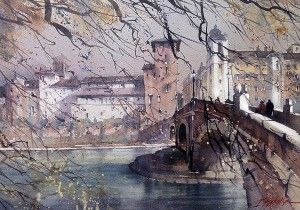
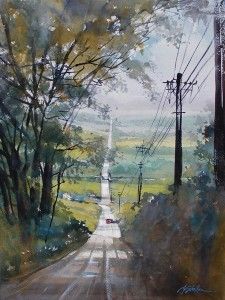
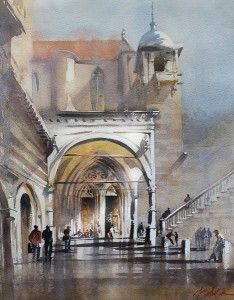
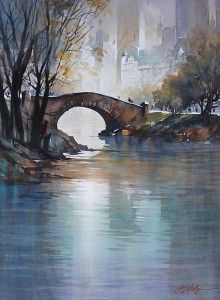
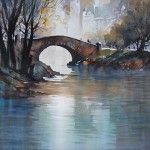
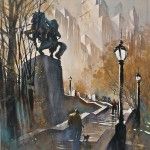
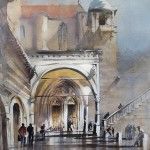
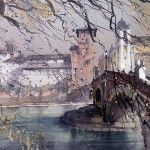
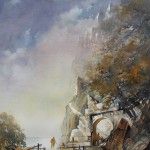
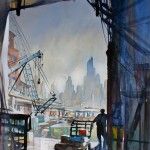
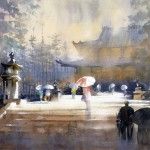
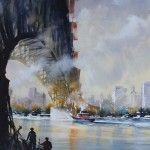
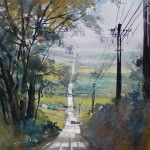
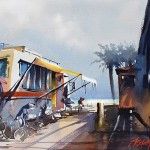
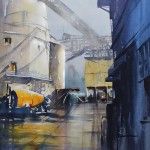
Thomas Schaller’s work is truly inspirational. Thank you Southwest Art for another fantastic article.